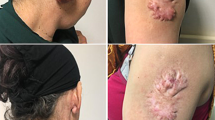Abstract
After the total excision of keloids, radiation therapy has been demonstrated as one of the most effective treatment methods to prevent a recurrence. This study was aimed to compare the effectiveness and side effects of single fraction electron beam radiotherapy (EBRT) and intra-lesional steroids (ILS) in preventing the recurrence of keloids postoperatively. Those patients who received EBRT within 24 h after the completion of keloid excision from the Plastic Surgery Department in a tertiary care institution in Southern India constituted the first group. The second group consisted of patients who received triamcinolone acetate injection intraoperatively along the wound edges and postoperatively into the scar every 3 weeks for 5 cycles. Both groups of patients were prospectively followed up. Out of 101 patients enrolled in the study, six patients were lost to follow-up. Ten patients developed postoperative complications. At the end of 1 year, 48.4% of all the patients were having a recurrence. The incidence of recurrence in the radiation group and steroid group were 56.5% and 40.8% respectively. Keloids of the ear lobe were having a significantly less number of recurrences at 1 year (8.3% vs 72.9%). There is no statistically significant difference between the outcomes of postoperative EBRT and ILS injection in the recurrence of keloids, although the steroid group had a 15.7% less incidence of recurrence. Keloids of the ear lobe and keloids with lengths less than 2 cm were having significantly less recurrence. About 10% of patients had mild postoperative complications.
Similar content being viewed by others
References
Emad M, Omidvari S, Dastgheib L, Mortazavi A, Ghaem H (2010) Surgical excision and immediate postoperative radiotherapy versus cryotherapy and intralesional steroids in the management of keloids: a prospective clinical trial. Med Princ Pract 19(5):402–405. https://doi.org/10.1159/000316381
Kelly AP (1988) Keloids. Dermatol Clin 6(3):413–424
Mahdavian Delavary B, van der Veer WM, Ferreira JA, Niessen FB (2012) Formation of hypertrophic scars: evolution and susceptibility. J Plast Surg Hand Surg 46(2):95–101. https://doi.org/10.3109/2000656X.2012.669184
Robles DT, Moore E, Draznin M, Berg D (2007) Keloids: pathophysiology and management. Dermatol Online J 13(3):9
Chalmers RL (2011) The evidence for the role of transforming growth factor-beta in the formation of abnormal scarring. Int Wound J 8(3):218–223. https://doi.org/10.1111/j.1742-481X.2011.00771.x
Marneros AG, Krieg T (2004) Keloids–clinical diagnosis, pathogenesis, and treatment options. J Dtsch Dermatol Ges 2(11):905–913. https://doi.org/10.1046/j.1439-0353.2004.04077.x
Louw L (2007) The keloid phenomenon: progress toward a solution. Clin Anat 20(1):3–14. https://doi.org/10.1002/ca.20374
Kal HB, Veen RE (2005) Biologically effective doses of postoperative radiotherapy in the prevention of keloids Dose-effect relationship. Strahlenther Onkol 181(11):717–723. https://doi.org/10.1007/s00066-005-1407-6
Kovalic JJ, Perez CA (1989) Radiation therapy following keloidectomy: a 20-year experience. Int J Radiat Oncol Biol Phys 17(1):77–80. https://doi.org/10.1016/0360-3016(89)90373-8
Song C, Wu HG, Chang H, Kim IH, Ha SW (2014) Adjuvant single-fraction radiotherapy is safe and effective for intractable keloids. J Radiat Res 55(5):912–916. https://doi.org/10.1093/jrr/rru025
Atiyeh BS (2007) Nonsurgical management of hypertrophic scars: evidence-based therapies, standard practices, and emerging methods. Aesthetic Plast Surg. 31(5):468–494. https://doi.org/10.1007/s00266-006-0253-y
Sclafani AP, Gordon L, Chadha M, Romo T (1996) Prevention of earlobe keloid recurrence with postoperative corticosteroid injections versus radiation therapy: a randomized, prospective study and review of the literature. Dermatol Surg 22(6):569–574. https://doi.org/10.1111/j.1524-4725.1996.tb00376.x
Lo TC, Seckel BR, Salzman FA, Wright KA (1990) Single-dose electron beam irradiation in treatment and prevention of keloids and hypertrophic scars. Radiother Oncol 19(3):267–272. https://doi.org/10.1016/0167-8140(90)90153-n
Mankowski P, Kanevsky J, Tomlinson J, Dyachenko A, Luc M (2017) Optimizing radiotherapy for keloids: a meta-analysis systematic review comparing recurrence rates between different radiation modalities. Ann Plast Surg 78(4):403–411. https://doi.org/10.1097/SAP.0000000000000989
Flickinger JC (2011) A radiobiological analysis of multicenter data for postoperative keloid radiotherapy. Int J Radiat Oncol Biol Phys 79(4):1164–1170. https://doi.org/10.1016/j.ijrobp.2009.12.019
Ogawa R, Yoshitatsu S, Yoshida K, Miyashita T (2009) Is radiation therapy for keloids acceptable? The risk of radiation-induced carcinogenesis. Plast Reconstr Surg 124(4):1196–1201. https://doi.org/10.1097/PRS.0b013e3181b5a3ae
Bischof M, Krempien R, Debus J, Treiber M (2007) Postoperative electron beam radiotherapy for keloids: objective findings and patient satisfaction in self-assessment. Int J Dermatol 46(9):971–975. https://doi.org/10.1111/j.1365-4632.2007.03326.x
Wagner W, Alfrink M, Micke O, Schäfer U, Schüller P, Willich N (2000) Results of prophylactic irradiation in patients with resected keloids–a retrospective analysis. Acta Oncol 39(2):217–220. https://doi.org/10.1080/028418600430806
Siotos C, Uzosike AC, Hong H et al (2019) Keloid excision and adjuvant treatments: a network meta-analysis. Ann Plast Surg 83(2):154–162. https://doi.org/10.1097/SAP.0000000000001951
Lee SY, Park J (2015) Postoperative electron beam radiotherapy for keloids: treatment outcome and factors associated with occurrence and recurrence. Ann Dermatol 27(1):53–58. https://doi.org/10.5021/ad.2015.27.1.53
Ogawa R, Hyakusoku H, Akaishi S, Nomoto S, Ono S (2007) Intraoperative repiercing for earlobe keloid. Ann Plast Surg 59(3):354–355. https://doi.org/10.1097/SAP.0b013e3180a032f3
Author information
Authors and Affiliations
Corresponding author
Ethics declarations
Conflict of Interest
The authors declare no competing interests.
Additional information
Publisher's Note
Springer Nature remains neutral with regard to jurisdictional claims in published maps and institutional affiliations.
Rights and permissions
About this article
Cite this article
Sreelesh, L.S., kutty, C.K.K., Prasanth, C.C. et al. Intralesional Keloid Excision Followed by Single Fraction Electron Beam Radiotherapy and Postoperative Local Steroids: a Non-randomized Open Study on Recurrence Rate. Indian J Surg 85, 516–521 (2023). https://doi.org/10.1007/s12262-022-03511-3
Received:
Accepted:
Published:
Issue Date:
DOI: https://doi.org/10.1007/s12262-022-03511-3




